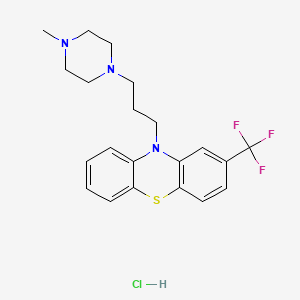








1. Apo Trifluoperazine
2. Apo-trifluoperazine
3. Apotrifluoperazine
4. Flupazine
5. Stelazine
6. Terfluzine
7. Trifluoperazine
8. Trifluoperazine Hcl
9. Trifluoperazine Hydrochloride
10. Trifluoroperazine
11. Trifluperazine
12. Triftazin
1. Cpd000059133
2. Mls000069471
3. Fluoperazine
4. Calmazine
5. Smr000059133
6. Stalazine Hydrochloride
7. 10h-phenothiazine,10-[3-(4-methyl-1-piperazinyl)propyl]-2-(trifluoromethyl)-, Hydrochloride (1:2)
8. Stelazine Dihydrochloride
9. Trifluperazine Dihydrochloride
10. Mls001146870
11. Mls002702821
12. Trifluoroperazine Dihydrochloride
13. 10-[3-(4-methylpiperazin-1-yl)propyl]-2-(trifluoromethyl)phenothiazine;hydrochloride
14. 10-[3-(4-methylpiperazinyl)propyl]-2-(trifluoromethyl)phenothiazine, Chloride, Chloride
15. Nsc17474
16. Skf 5019
17. Eskazine Dihydrochloride
18. Triflurin Dihydrochloride
19. Opera_id_1296
20. Trifluoperazine Hydrochoride
21. Chembl1710
22. Schembl41194
23. Tripfluoperazine Hydrochloride
24. Mls000758242
25. Mls001423986
26. Mls002222216
27. Triflorperazine Dihydrochloride
28. Trifluoropyrazin Dihydrochloride
29. Pharmakon1600-01500591
30. Nsc757369
31. Akos016395836
32. Ccg-100803
33. Nc00053
34. Ncgc00180883-01
35. Ncgc00180883-02
36. Wln: T C666 Bn Isj Exfff B3- At6n Dntj D1 &gh 2
| Molecular Weight | 444.0 g/mol |
|---|---|
| Molecular Formula | C21H25ClF3N3S |
| Hydrogen Bond Donor Count | 1 |
| Hydrogen Bond Acceptor Count | 7 |
| Rotatable Bond Count | 4 |
| Exact Mass | 443.1409812 g/mol |
| Monoisotopic Mass | 443.1409812 g/mol |
| Topological Polar Surface Area | 35 Ų |
| Heavy Atom Count | 29 |
| Formal Charge | 0 |
| Complexity | 510 |
| Isotope Atom Count | 0 |
| Defined Atom Stereocenter Count | 0 |
| Undefined Atom Stereocenter Count | 0 |
| Defined Bond Stereocenter Count | 0 |
| Undefined Bond Stereocenter Count | 0 |
| Covalently Bonded Unit Count | 2 |
Antiemetics
Drugs used to prevent NAUSEA or VOMITING. (See all compounds classified as Antiemetics.)
Antipsychotic Agents
Agents that control agitated psychotic behavior, alleviate acute psychotic states, reduce psychotic symptoms, and exert a quieting effect. They are used in SCHIZOPHRENIA; senile dementia; transient psychosis following surgery; or MYOCARDIAL INFARCTION; etc. These drugs are often referred to as neuroleptics alluding to the tendency to produce neurological side effects, but not all antipsychotics are likely to produce such effects. Many of these drugs may also be effective against nausea, emesis, and pruritus. (See all compounds classified as Antipsychotic Agents.)
Dopamine Antagonists
Drugs that bind to but do not activate DOPAMINE RECEPTORS, thereby blocking the actions of dopamine or exogenous agonists. Many drugs used in the treatment of psychotic disorders (ANTIPSYCHOTIC AGENTS) are dopamine antagonists, although their therapeutic effects may be due to long-term adjustments of the brain rather than to the acute effects of blocking dopamine receptors. Dopamine antagonists have been used for several other clinical purposes including as ANTIEMETICS, in the treatment of Tourette syndrome, and for hiccup. Dopamine receptor blockade is associated with NEUROLEPTIC MALIGNANT SYNDROME. (See all compounds classified as Dopamine Antagonists.)
